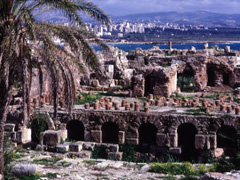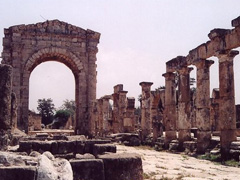

: GUIDE INFO :
- About Us
- Contact Us
- Social Media
- F.A.Q
- Plans
- Albums
- News & Events
- Get A Website
- Marketing Tips
- Useful Links
- International Links
: HOTELS DIRECTORY :
- Beirut Hotels
- Bekaa Hotels
- Mount Lebanon Hotels
- North Lebanon Hotels
- South Lebanon Hotels
: LEBANON INFO :
- Transportation In Lebanon
- Touristic Sites
- Featured Resorts
- Resorts>
- Grottos
- Embassies in Lebanon
- Photo Gallery
- Articles About Lebanon
- Songs About Lebanon
: SISTER SITES :
- AtLebanon Directory
- Advertise Lebanon
- Professional Innovations
- Lebanon Auto Guide
- Bcharre Chalet & Motel
: GOOGLE ADS :
|
» TYRE CITY LEBANON
 One of the most important cities of the ancient world. 83km south of Beirut, Tyre was founded after Sidon in the 3rd millennium BC. It originally consisted of a mainland settlement and an island city, but these were joined in the 4th century BC by Alexander the Great with causeway which converted the island into a peninsula. The city contains three areas of great interest. The first is the Phoenician Island with remains of civic buildings, colonnades, public baths, and mosaic streets.
One of the most important cities of the ancient world. 83km south of Beirut, Tyre was founded after Sidon in the 3rd millennium BC. It originally consisted of a mainland settlement and an island city, but these were joined in the 4th century BC by Alexander the Great with causeway which converted the island into a peninsula. The city contains three areas of great interest. The first is the Phoenician Island with remains of civic buildings, colonnades, public baths, and mosaic streets.
 The third site of interest is Tyre's Crusader cathedral. Located 6km south of Tyre is Ras Al-Ain, the city's main source of water since Phoenician days. Its artisan wells gush up into stone reservoirs that have been maintained through the ages. One of the reservoirs fed the arched aqueducts of the Roman period that once stretched all the way to Tyre. Remains of these aqueducts can be seen along the Roman road running under the monumental arch on the necropolis.
The third site of interest is Tyre's Crusader cathedral. Located 6km south of Tyre is Ras Al-Ain, the city's main source of water since Phoenician days. Its artisan wells gush up into stone reservoirs that have been maintained through the ages. One of the reservoirs fed the arched aqueducts of the Roman period that once stretched all the way to Tyre. Remains of these aqueducts can be seen along the Roman road running under the monumental arch on the necropolis.
|
|










 Lebanon Auto Guide
Post,Buy your car.
Lebanon Auto Guide
Post,Buy your car.
 Chalets & Loding Rooms
One of Besharry/Al-Arz Tourists Destination
Chalets & Loding Rooms
One of Besharry/Al-Arz Tourists Destination